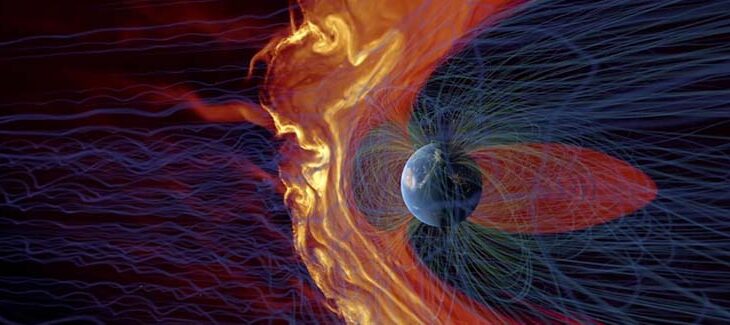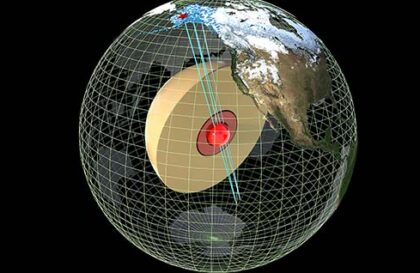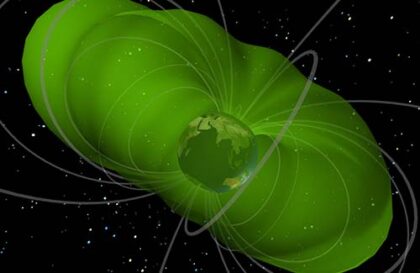The sustained wind detected by ESA’s Cluster mission is slowly escaping from Earth’s plasmasphere – the plasma torus surrounding our planet’s atmosphere. The outflow is almost 90 tons per day. But this protection comes at a cost because the ejected particles gain enormous speed as they leave the atmosphere, become trapped in the Earth’s magnetic field, and end up encircling the Earth, where they form a hot plasma cloud around the planet.
What’s happening?
The outer space surrounding the Earth, outside the outer layers of the atmosphere, is formed by its magnetic field, filling with electrons and ions moving along magnetic lines. The interaction of the magnetic field with the solar wind creates a magnetosphere with a complex structure.
Inside the magnetosphere is the plasmasphere, a donut-shaped region that rotates with the Earth. It exchanges energy with the outer layers of the magnetosphere. Research from ESA’s Cluster mission has shown that persistent wind transfers plasma from the plasmasphere to the magnetosphere, as predicted by theory in the 90s.
But this is not the only source of plasma leakage.
Source #2 of plasmasphere loss
The plasmasphere also supplies material to the outer magnetosphere during sporadic, localized, and powerful events called plumes.
Plumes are dense columns of plasma in the plasmasphere, formed due to geomagnetic storms – disturbances in the Earth’s magnetic environment caused by fluctuations in the solar wind. Once created, the plumes grow and explode, releasing a mass of plasma into the outer regions of the magnetosphere. This process leads to partial depletion of the plasmasphere.
The Earth is losing its plasmasphere. How fast?
Early studies of the plumes made it possible to determine how long it would take to replenish the plasmasphere after such an event.
Theoretical research by scientists
In 1992, Joseph Lemaire from Belgium and Robert Schunk from the USA theoretically studied the interaction of forces in the plasmasphere. They identified an imbalance between the Earth’s gravity, the centrifugal force from its rotation, and plasma pressure. This imbalance causes instability, creating a plasma wind that constantly flows from the plasmasphere to the magnetosphere.
Practical Data from Cluster Missions
The Cluster Ion Spectrometry CIS. Credit: ESA
While the Cluster mission collected data, researchers from the Research Institute of Astrophysics and Planetology in Toulouse, France, decided that the Cluster Ion Spectrometry experiment CIS would be ideal for testing plasmaspheric flow. The plasmaspheric wind was assumed to be constant, while the plumes were formed during high magnetospheric activity.
Cluster special configuration. Credit: ESA
The study required high precision since the estimated wind was feeble. But thanks to the sensitivity of the CIS experiment and special data analysis filters, the researchers discovered winds that eject 90 tons of plasma per day into the magnetosphere. This amount of lost plasma seems insignificant compared to the total mass of the Earth’s atmosphere of 1018 kg.
However, this persistent wind plays a significant role in supplying plasma to the outer magnetosphere, second in efficiency only to the solar wind, which is also a persistent source, and the random and powerful plume.
What does plasma do around the Earth?
Plasma serves as a shield for us. The Earth’s protective barrier in space is a region of the outer ionosphere at 180 to 620 miles (300 to 1,000 kilometers) where electrically charged atoms are concentrated.
Just as the outer layers of the shuttle’s heat shield fall away during its hot return, the Earth’s shield absorbs the energy of cosmic storms, throwing some of its charged particles into space.
The solar wind is a fast-moving plasma emanating from the Sun at about 250 miles per second (400 kilometers per second). Without the Earth’s protective magnetic field, this wind could directly affect our atmosphere, gradually destroying it. But thanks to the magnetosphere, the solar wind bypasses the Earth without causing harm. However, during cosmic storms, when solar activity increases, the magnetosphere experiences even greater pressure due to the solar magnetic field’s increased speed, density, or strength.
The magnetosphere protects the Earth from the solar wind, a plasma of charged particles. It creates a powerful electrical current in the Earth’s magnetosphere of millions of amperes, pumping trillions of watts of energy. It is especially active in polar regions, causing auroras. Without this protection, heat from the currents would expand the lower ionosphere, creating problems for spacecraft in orbit.
Could Earth lose plasmasera?
Credit: NASA
The first observations from NASA’s Imager for Magnetopause to Aurora Global Exploration (IMAGE) show how Earth’s magnetosphere absorbs cosmic storm current and releases charged particles into space. Fuselier used the Low Energy Neutral Atom (LENA) on IMAGE and found that charged oxygen atoms are released in response to the heating of the ionosphere. During a space storm, about as much ionosphere is lost as the air in the Louisiana Superdome weighs.
The second IMAGE observation points to the cost of protection our magnetosphere provides. Due to their charge, Ions thrown into space are intercepted by the Earth’s magnetic forces and move along its magnetic lines, just as cars drive along the road. The solar wind distorts the magnetosphere, similar to how a strong wind distorts an umbrella. The part of the magnetosphere facing away from the Sun is stretched, forming a long “tail” under the influence of this solar wind.
Since magnetic fields are like rubber bands, they resist this stretching. But when the tension becomes excessive, part of the magnetosphere “bounces” back toward Earth, carrying the ejected ions from the ionosphere like a catapult.
The research team used the instrument to track the High Energy Neutral Atom (HENA) on IMAGE, which was accelerated to breathtaking speeds of 2,500 miles per second (about 4,000 km/sec). These particles quickly appeared in the northern and southern auroras and in the resulting warm plasma cloud during solar storms.
The Earth is the source of these particles, while the solar wind adds the necessary energy, transforming this cold atmospheric resource into hot plasma. Without our ionosphere providing the particles, this plasma cloud would be much weaker and dry over time.
Such discoveries provide new insight into the mechanisms of space storms that generate plasma flows that can interfere with navigation using Global Positioning System satellites.
Discovery Data Providers
This study is based on cluster ion spectrometry (CIS) data from the Cluster spacecraft collected in 2001, 2002, and 2006.
The Cluster mission comprises. Credit: ESA
Cluster is a group of four spacecraft launched in 2000 to study processes in the Earth’s magnetosphere in three dimensions. They move in a polar orbit around the Earth. Their equipment makes it possible to measure electric and magnetic fields and study the parameters of electrons and ions of different energies.
Banner image: Solar plasma interacts with Earth’s magnetic field in this computer-generated visualization. Credit: Advanced Visualization Lab, National Center for Supercomputing Applications, University of Illinois, Urbana-Champaign (National Science Foundation Award 1445176)
Image credit:
https://eos.org
https://sci.esa.int
https://www.esa.int
https://svs.gsfc.nasa.gov
https://www.esa.int






